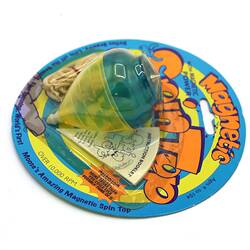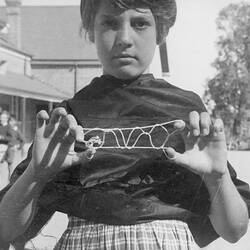Summary
Alternative Name(s): Peg Top, Spin Top
Made: Moose Enterprise, circa - 1997
Obtained by curator Susan Barnett, for the Springvale Historical Society's 'World of Games' exhibition, 1997. Donated by Moose Enterprise, Melbourne, Vic. to Springvale Historical Society, 1997.
The Australian Children's Folklore Collection is unique in Australia, documenting contemporary children's folklore across Australia and in other countries reaching back to the 1870s. The Collection has a strong component of research material relating to Victoria.
Top-spinning is an ancient activity. Tops dated at 1200-1400BC were excavated in Egypt, and they are often mentioned in classical literature. They are found throughout the world and used by adults and children, in rituals as well as for games of skill. There are many different kinds of tops, and the way they are used depends on their size and shape. This is an example of a commercially-produced top made from contemporary materials and with an added feature - it has a magnet at the top, enabling it to be used in different ways to the usual traditional tops. The top is a peg top, and is started the same way as traditional peg tops, by throwing it downwards and jerking the string to set it spinning. Peg tops are not normally used by Australian children in the playground in the 1990s.
Physical Description
Plastic magnetic top, in original packaging, unopened. Top is blue and yellow transparent plastic with moulded rings around the body. Inside, and protruding through to flat top surface is a metal magnet. The top is inside a moulded clear plastic covering which is glued to a round cardboard backing. Also inside the covering is a white twisted cotton string attached to a metal ring, and an instruction booklet. Printed on the cardboard backing are manufacturer's name, details of the top's activities, instructions about how to start it spinning and images of the three tops in the series. Acknowledgement: Australian Children's Folklore Collection, Museum Victoria.
More Information
-
Collection Names
-
Collecting Areas
-
Acquisition Information
Cultural Gifts Donation from Dr June Factor, 18 May 1999
-
Acknowledgement
Donated through the Australian Government's Cultural Gifts Program.
-
Manufacturer
-
Inscriptions
On cardboard backing: Magnetic Spin Top/Moose's/ HURRICANE MST - 100/OVER 10,000 RPM. On back of card: extensive text: Instructions, Magnetic/Spin Top./COOL! Manufacturer's details.
-
Classification
-
Category
-
Discipline
-
Type of item
-
overall dimensions
16 cm (Length), 6 cm (Width), 16 cm (Height)
-
References
Gould, D.W.; The Top, Universal Toy, Enduring Pastime; Bailey Bros & Swinfen Ltd., Folkestone, England. 1975
-
Keywords
Amusements, Children's Play, Chinese Communities, Chinese Immigration, Games, Marketing, Packaging, Toys, Making History - Australian Childrens Folklore



